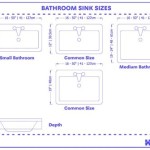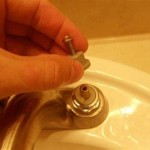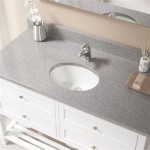Installing a Bathroom Sink
Installing a new bathroom sink can dramatically enhance the aesthetic and functionality of a space. Whether replacing an outdated fixture or undertaking a complete bathroom renovation, a properly installed sink is essential. This process requires careful planning and execution, but with the right tools and guidance, it can be accomplished effectively.
Preparing for Installation
Careful preparation streamlines the installation process and minimizes potential problems. Before beginning, gather all necessary tools and materials. This includes:
- New sink and faucet
- Basin wrench
- Adjustable wrench
- Pliers
- Screwdrivers
- Plumber's putty
- Silicone caulk
- Supply lines
- Drain assembly
- Teflon tape
- Safety glasses
- Bucket
- Towels
Next, turn off the water supply to the existing sink. This is crucial to prevent leaks during removal and installation. Turn off both the hot and cold water valves located under the sink. Then, open the faucet to release any remaining water pressure in the lines.
Removing the Old Sink
Removing the existing sink requires disconnecting the plumbing and detaching the fixture from the countertop or vanity. Firstly, disconnect the P-trap, located beneath the sink, using a basin wrench. Place a bucket underneath to catch any remaining water. Then, disconnect the supply lines from the shut-off valves using an adjustable wrench. Depending on the sink's installation method, it may be secured with clips, screws, or adhesive. Carefully detach the sink, taking care not to damage the surrounding surfaces.
Installing the New Sink
Once the old sink is removed, the installation of the new fixture can begin. The specific steps will vary slightly depending on the type of sink (drop-in, undermount, pedestal) and the countertop material.
Installing a Drop-In Sink
For a drop-in sink, a bead of plumber's putty is typically applied around the cut-out in the countertop. The sink is then carefully lowered into the opening, pressing firmly to create a seal. Excess putty should be removed with a putty knife.
Installing an Undermount Sink
Undermount sinks require securing the sink from below the countertop. This often involves using clips and screws. A silicone sealant is usually applied between the sink and the countertop to create a watertight seal.
Connecting the Plumbing
With the sink secured, the next step is connecting the plumbing. Begin by installing the faucet according to the manufacturer's instructions. Then, connect the supply lines to the faucet's tailpieces, ensuring a tight seal using an adjustable wrench and Teflon tape. Connect the drain assembly to the sink drain, using plumber's putty to seal the drain flange to the sink. Finally, connect the P-trap to the drain assembly and the waste line, tightening all connections securely.
Testing the Installation
Once all connections are made, it’s essential to test the installation for leaks. Turn on the water supply slowly and check for any drips or leaks around the supply lines, drain connections, and the seal between the sink and the countertop. If any leaks are found, tighten the connections or reapply sealant as needed. Run the water for several minutes to ensure proper drainage and check the hot and cold water functionality. If everything is working correctly, the installation is complete.
Final Touches and Maintenance
After successful testing, apply a bead of silicone caulk around the perimeter of the sink where it meets the countertop. This creates a finished look and further prevents water seepage. Regular cleaning with mild soap and water will help maintain the sink's appearance and prevent staining. Avoid using abrasive cleaners as they can scratch the surface. Periodically check the plumbing connections for any signs of leakage and tighten them if necessary.
Troubleshooting Common Issues
Occasionally, issues may arise during or after installation. A slow-draining sink can often be resolved by clearing a clog in the P-trap or drain line. Leaks around the supply lines may indicate a loose connection or a damaged washer. If the faucet drips, it may require replacing the cartridge or O-rings. If unsure about any aspect of the installation or troubleshooting process, consulting a qualified plumber is recommended.

How To Fit A Bathroom Sink Diy Guides Victorian Plumbing

How To Install A Bathroom Vanity

How To Install A Bathroom Vanity And Sink

How To Install A Bathroom Sink Step By Guide

Here S How Install A Bathroom Pedestal Sink

How To Install A Bathroom Sink Taskrabbit Blog

How To Install Or Remove A Bathroom Vanity Homeserve Usa

How To Install A Vessel Sink Step By Instructions

12 Easy Steps To Install Bathroom Vanity And Sink

Ge Sealants How To Install A Drop Sink
Related Posts







